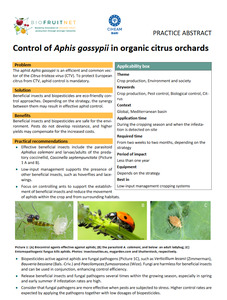{Tool} Control of Aphis gossypii in organic citrus orchards (BIOFRUITNET Practice Abstract). Creator(s): Avosani, Sabina and Verrastro, Vincenzo. Issuing Organisation(s): CIHEAM Bari - Mediterranean Agronomic Institute of Bari. Biofruitnet Practice Abstract, no. 098. (2022)
|
PDF
- Published Version
- English
(Control of Aphis gossypii in organic citrus orchards)
339kB | |
|
PDF
- Published Version
- Italian/Italiano
(Controllo di Aphis gossypii in un agrumeto biologico)
338kB | |
![[thumbnail of 2024-05-06 09_24_42-Control of Aphis gossypii in organic citrus orchards - 98_PA_aphis gossypii_Fina.png]](/44999/5.hassmallThumbnailVersion/2024-05-06%2009_24_42-Control%20of%20Aphis%20gossypii%20in%20organic%20citrus%20orchards%20-%2098_PA_aphis%20gossypii_Fina.png)  Preview |
Image (PNG)
- Cover Image
- English
265kB |
Document available online at: https://orgprints.org/44999
Summary in the original language of the document
Beneficial insects and biopesticides are safe for the environment. Pests do not develop resistance, and higher yields may compensate for the increased costs.
Practical recommendations
• Effective beneficial insects include the parasitoid Aphidius colemani and larvae/adults of the predatory coccinellid, Coccinella septempunctata (Picture 1 A and B).
• Low-input management supports the presence of other beneficial insects, such as hoverflies and lacewings.
• Focus on controlling ants to support the establishment of beneficial insects and reduce the movement of aphids within the crop and from surrounding habitats.
• Biopesticides active against aphids are fungal pathogens (Picture 1C), such as Verticillium lecanii (Zimmerman), Bauveria bessiana (Bals.-Criv.) and Paecilomyces fumosoroseus (Wize). Fungi are harmless for beneficial insects and can be used in conjunction, enhancing control efficiency.
• Release beneficial insects and fungal pathogens several times within the growing season, especially in spring and early summer if infestation rates are high.
• Consider that fungal pathogens are more effective when pests are subjected to stress. Higher control rates are expected by applying the pathogens together with low dosages of biopesticides.
• Abamectin and Azadirachtin are efficient biopesticides but could have negative effects on beneficial insects if simultaneously used. Therefore, release beneficial insects 7-10 days after treatment with these biopesticides.
| EPrint Type: | Practice tool |
|---|---|
| What problem does the tool address?: | The aphid Aphis gossypii is an efficient and common vector of the Citrus tristeza virus (CTV). To protect European citrus from CTV, aphid control is mandatory. |
| What solution does the tool offer?: | Beneficial insects and biopesticides are eco-friendly control approaches. Depending on the strategy, the synergy between them may result in effective aphid control. |
| Country: | Italy |
| Type of Practice Tool: | Practice abstracts |
| Keywords: | Crop production, Pest control, Biological control, Citrus |
| Agrovoc keywords: | Language Value URI English crop production http://aims.fao.org/aos/agrovoc/c_5976 English pest control http://aims.fao.org/aos/agrovoc/c_5726 English biological control http://aims.fao.org/aos/agrovoc/c_918 English Citrus http://aims.fao.org/aos/agrovoc/c_1637 |
| Subjects: | Crop husbandry > Production systems > Fruit and berries Crop husbandry > Crop health, quality, protection |
| Research affiliation: | European Union > Horizon 2020 > Biofruitnet Italy > IAMB Mediterranean Agronomic Institute Bari European Union > Organic Farm Knowledge |
| Horizon Europe or H2020 Grant Agreement Number: | 862850 |
| Related Links: | https://organic-farmknowledge.org/tool/44999, https://biofruitnet.eu |
| Project ID: | ofk |
| Deposited By: | Basler, Andreas |
| ID Code: | 44999 |
| Deposited On: | 25 Dec 2022 10:21 |
| Last Modified: | 06 May 2024 07:25 |
| Document Language: | English, Italian/Italiano |
| Status: | Published |
Repository Staff Only: item control page

 Download Statistics
Download Statistics Download Statistics
Download Statistics
